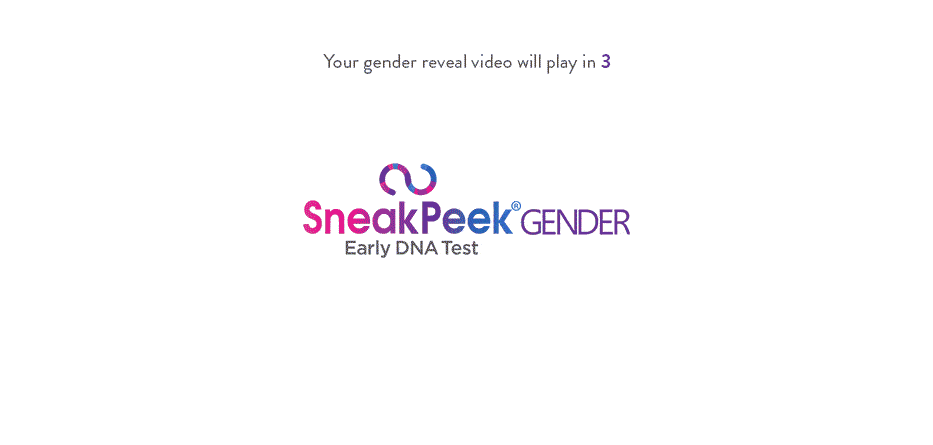Typically, a NIPT can determine if you are expecting two girls or at least one boy in your pregnancy.
Most NIPT tests are unable to determine if you are carrying two boys or one of each gender.
The Panorama NIPT is the exception. It can tell you the sexes of both babies and if they are identical or fraternal.
SneakPeek explains:
“If no male DNA is detected, you can expect twin girls coming your way. If male DNA is detected, you either have a boy and a girl, or two boys.
SneakPeek cannot detect if both babies are boys based on the amount of male DNA, only if you’re carrying a boy at all.”
Table of Contents
NIPT Tests and Twins
NIPT tests can tell you much more about your baby, or babies, than their gender.
They can give you crucial genetic information that can be both reassuring and helpful as you prepare to meet your little one(s).
Can NIPT Detect Twins’ Gender?
While NIPT is accurate in determining the gender of a singleton, most are not as accurate with twin pregnancies.
Because the test works by detecting Y chromosomes, it can tell you if you are having two girls with certainty.
If a Y chromosome is detected, you will know that you are having at least one boy.
However, it will not tell you if both babies are boys.
The best way to determine the gender of both twins is to wait until the sex can be determined via ultrasound, usually between 15 and 20 weeks.
An exception is the Panorama NIPT test. It claims to be able to conclusively tell you the sex of each twin and whether the twins are identical or fraternal.
How Accurate Is NIPT for Twins?
Studies have shown that NIPT can be very accurate (99% sensitivity) and reliable for detecting the risks of genetic disorders.
It is most accurate for detecting the risk of Down Syndrome and less accurate for other disorders such as trisomy 18 and trisomy 13.
Some NIPTs can even identify a vanishing twin.
It is important to reiterate that the test is not always 100% accurate and is not a diagnostic test for either twin or singleton pregnancies.
It is possible to get a false positive or false negative, and there are cases of both.
While it is mostly accurate, the test does have its limitations, and certain factors can increase the chances of an inaccurate or failed reading.
Carrying multiples is a factor that can make the test less effective.
How a NIPT Test Works
Noninvasive prenatal testing is a method of testing a pregnant woman’s blood in order to determine the likelihood that her child will be born with certain genetic abnormalities.
When a woman is pregnant, her blood contains floating DNA from her cells and cells from the placenta that are identical to the DNA of her child.
These fragments are analyzed in a lab for signs of genetic abnormalities.
What the NIPT Test Screens For
NIPT is often used to look for chromosomal disorders including:
- Down Syndrome
- Edward’s Syndrome (trisomy 18)
- Patau Syndrome (trisomy 13 )
- Turner Syndrome (females)
- Klinefelter Syndrome (males)
- Triple X Syndrome
What the NIPT Test Does Not Screen For
Some chromosomal defects that most NIPT tests are incapable of screening for include:
- Heart defects
- Abdominal wall defects
- Spina bifida, anencephaly, and other open neural tube defects
- Cleft palate and other physical deformities
- Genetic disorders such as sickle cell anemia
- Cystic fibrosis
NIPT Test for Gender
The blood sample taken for NIPT provides doctors with loads of information about the fetus, including the gender!
NIPT tests search for Y chromosomes to determine if the fetus is a girl or a boy. Normally, this testing can be done as early as the first trimester.
NIPT Test Gender Accuracy
The accuracy of the genetic blood gender tests is very high. Clinical studies have found them to be 98-99% accurate.
The sensitivity and accuracy of the test also increase with gestational age; therefore, the later you get the test, the more accurate it will be.
Can the NIPT Test Be Done at Home?
If you feel comfortable enough to try it at home, there are kits that you can buy online.
Once you receive your kit, you draw your blood sample and then mail it off to a lab for testing and wait for your results!
When To Do a NIPT Test
NIPT testing can be done as early as 10 weeks of pregnancy up to delivery.
There is not usually enough fetal DNA in the mother’s bloodstream before 10 weeks gestation.
Most providers will recommend doing the test between 11 and 13 weeks gestation.
How a NIPT Is Given
The NIPT is performed with a simple maternal blood draw from the mother’s arm.
Once the sample is collected, it will be sent to a specific lab where it will be analyzed, and your doctor will have the results a few days or weeks later.
Is NIPT the Same as First Trimester Screening?
The short answer is, no, they are not the same thing.
The First Trimester Screening includes blood work and a detailed ultrasound between weeks 11 and 13.
The blood work tests for two pregnancy hormones and the three most common trisomies.
The ultrasound measures the baby’s fetal nuchal translucency (NT), or the amount of fluid in the back of his/her neck, which is a common indicator of Down Syndrome.
NIPT testing is additional testing that can be done, often at the patient’s expense.
It has a higher detection rate and can be more accurate than the traditional screening.
Are NIPT Tests Only for High-Risk Pregnancies?
NIPT tests are available for all pregnant women, regardless of their age or baseline risk.
NIPT Testing Cost
NIPT tests are becoming more readily available for pregnant women, but the cost ultimately depends on your insurance plan.
NIPT is typically covered by insurance when it is considered medically necessary by a doctor and you meet the coverage criteria set by the insurance plan.
The cost of the test can range from $800 to $3,000, but what you pay depends on your plan’s benefits.
If you are uninsured or if your insurance company does not cover NIPT, most laboratories have flexible programs to help with the cost of testing.
Which NIPT Test Is Best?
There really is no one right answer! There are several reliable and advanced NIPT tests available.
When figuring out which is the best test for you, your doctor will consider several different factors including your age, what the test screens for, whether an egg donor was used, and which tests are covered by insurance.
Natera Panorama
Panorama is one of the most widely used NIPT tests. It screens for most genetic conditions and claims to have the lowest reported false positive rate.
This test is not available for mothers carrying triplets, surrogate mothers carrying twins, or women who have used an egg donor.
However, if you are carrying twins, this test will be able to determine the gender of both babies and whether they are identical or fraternal.
Harmony
The Harmony test has been studied in scientific publications and has been extensively demonstrated in twin and singleton pregnancies.
It tests for the same disorders as the Panorama, but it may have more reasons for being used for twin pregnancies.
Illumina
The Illumina NIPT test is known for its use of innovative sequencing and array technologies that allow for advantages over other NIPT technologies.
SneakPeek® DNA Test Gender Prediction
This is an at-home option for those who may not have insurance or a plan that will cover the cost of the test from your provider.
While it does not screen for genetic abnormalities, it can be used to determine the gender of your baby.
When I was pregnant with twins, not knowing their genders was killing my husband and me. We ended up ordering the SneakPeek DNA Test.
Shortly after sending it in, we got an email with this exciting news…(see below!).

If you’re dying to know your twins’ genders, you can save $10 on your order through this link.
Panorama vs. Harmony Test
Both of these NIPT tests have high accuracy rates and screen for the same common disorders. There are some minor differences.
For example, the Panorama test can be performed at 9 weeks while the Harmony test can be performed at 10 weeks.
The Gynae Center in the UK, outlined the differences in an easy-to-understand chart here.
How To Read NIPT Test Results
Test results may be reported as “low risk” (negative) or “high risk” positive.
A NIPT result that is read as low risk means that the baby is not likely to have any of the specific chromosomal disorders that were screened.
If a high-risk result comes back, it means that the baby has a good chance of having the specific disorder that was screened.
Mom of three (including identical twin boys), wife, and owner of Parents Wonder. This is my place to share my journey as a mother and the helpful insights I learn along the way.

